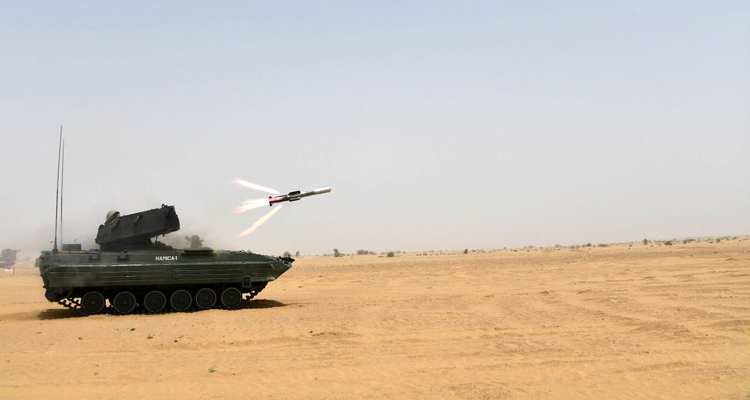INDIAN ARMED FORCES CHIEFS ON OUR RELENTLESS AND FOCUSED PUBLISHING EFFORTS

The insightful articles, inspiring narrations and analytical perspectives presented by the Editorial Team, establish an alluring connect with the reader. My compliments and best wishes to SP Guide Publications.

"Over the past 60 years, the growth of SP Guide Publications has mirrored the rising stature of Indian Navy. Its well-researched and informative magazines on Defence and Aerospace sector have served to shape an educated opinion of our military personnel, policy makers and the public alike. I wish SP's Publication team continued success, fair winds and following seas in all future endeavour!"

Since, its inception in 1964, SP Guide Publications has consistently demonstrated commitment to high-quality journalism in the aerospace and defence sectors, earning a well-deserved reputation as Asia's largest media house in this domain. I wish SP Guide Publications continued success in its pursuit of excellence.
- MoD initiates comprehensive review of Defence Acquisition Procedure 2020, pushes for defence reforms
- G7: The Swansong
- Kalinga Connect: South Asia to Polynesia
- Must Credit DRDO for Operation Sindoor, now what is next for defence R&D?
- The layered Air Defence systems that worked superbly, the key element of Operation Sindoor
- Operation Sindoor | Day 2 DGMOs Briefing
- Operation Sindoor: Resolute yet Restrained
Last of the missiles conceived by Kalam in 1983 finally ready for induction
NAG Anti-Tank Guided Missile gets approval from the Army after grueling summer trials

India on July 19 declared its indigenous third-generation anti-tank guided missile (ATGM) NAG ready for induction as an operational weapon in the Army. A helicopter-launch version has also been developed. This is the last of the missile systems conceived under the Integrated Guide Missile Development Programme (IGMDP) in 1983 which will now be produced industrially to be used as an operational military weapon.
The announcement follows successful completion of summer user trials by the Indian Army at the Pokhran Field Firing Ranges in Rajasthan from July 7 to 18.. The 4 km range missile cleared winter trials in February 2019.
Finally coming good 39 years after its conception, the NAG has reduced the market for foreign-made ATGMs in India. The maturity of this indigenous missile is reportedly the reason for putting on the backburner a larger order for the Israeli Spike to equip frontline battalions of the Army
Finally coming good 39 years after its conception, the NAG has reduced the market for foreign-made ATGMs in India. The maturity of this indigenous missile is reportedly the reason for putting on the backburner a larger order for the Israeli Spike to equip frontline battalions of the Army. The US, too, has been pushing the Javelin ATGM. Both claim that their missiles are a generation ahead of the competition.
Indigenously developed NAG – 3rd Generation Anti- Tank Guided Missile (ATGM) has successfully undergone series of user’s trails at Pokhran Field Firing Ranges. @PMOIndia @DefenceMinIndia @SpokespersonMoD @adgpi pic.twitter.com/UbDcDCpMjM
— DRDO (@DRDO_India) July 19, 2019
India's Ministry of Defence claimed a 100 per cent success rate in user trials for the NAG, which has been developed by the Defence Research and Development Organisation (DRDO).
"As part of the NAG summer user trials, six missions were conducted under the extreme temperature conditions of the Pokhran Ranges. All the missiles have met the mission objectives including minimum range, maximum range, in direct attack as well as top attack modes and achieved a direct hit on to the target," the Ministry of Defence announced in a statement. The imaging algorithm withstood the test of severe hot weather conditions in ensuring the missile hit the target.
The IGMDP - under which the NAG was conceived along with the Prithvi, Agni, Trishul and Akash missiles under the leadership of the legendary Missile Man, Dr APJ Abdul Kalam in 1983 - was itself brought to a close in 2008. The only missile under the IGMDP which was abandoned was the Trishul, which was meant to be a short-range anti-missile missile
"All the ten missiles, which were fired during winter and summer trails, successfully hit the targets," the statement added..
The IGMDP - under which the NAG was conceived along with the Prithvi, Agni, Trishul and Akash missiles under the leadership of the legendary Missile Man, Dr APJ Abdul Kalam in 1983 - was itself brought to a close in 2008. The only missile under the IGMDP which was abandoned was the Trishul, which was meant to be a short-range anti-missile missile. In 2008, the Trishul was consigned as a technology demonstrator after a failed development effort, which also compelled India to go in for the Israeli Barak.
Raksha Mantri Shri @rajnathsingh has congratulated the user evaluation teams from Indian Army and @DRDO_India on NAG’s successful completion of user trials.
— ????? ?????? ????????/ RMO India (@DefenceMinIndia) July 19, 2019
India's had greater success with strategic missiles than with tactical ones.
The NAG is an all-weather ATGM with day and night capability, developed to destroy highly fortified enemy tanks within a range bracket of 500 metres to 4 km. It is a fire and forget missile which uses an imaging infra red seeker in lock-on-before-launch mode.
The missile is launched from the NAG missile carrier (NAMICA) - a modified BMP-2 Infantry Combat Vehicle - which is capable of carrying up to six combat missiles. The imaging algorithm withstood the test of severe hot weather conditions in ensuring the missile hit the target.
This ATGM uses an 8 kg tandem HEAT warhead capable of penetrating Explosive Reactor Armour and Composite Armour. Integration work is going on to retrofit the Rudra helicopter with the Helina variant of the NAG. The helicopter-launched version has a nose-mounted thermal imaging system for guiding the missile.





